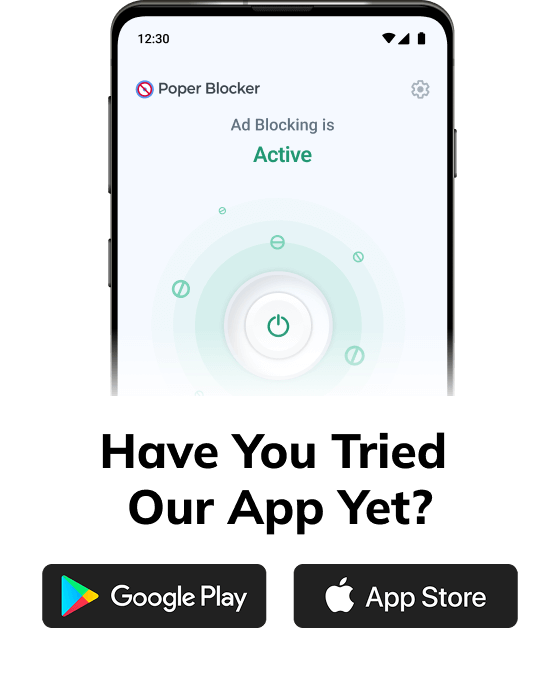Try browsing major websites without ad-blockers – it’s like taking off your seatbelt and navigating a crowded motorway on a motorbike without a helmet.
The rise of online ads
Advertising on the internet has seen a lot of changes since the days of the early static, unobtrusive banners that were posted on the first commercial websites. These ads remained stationary, and seamlessly integrated into the layout of the page. Nowadays, when user engagement has grown significantly, businesses try to make advertising more effective and interesting by employing advanced ad formats: from animated banners to personalized messages, to interactive ads. Tracking technologies revolutionized online advertising by allowing marketers to monitor users’ online behavior and show relevant ads to various target audiences.
The world of intrusive advertising today is bigger than ever. Now it can be invasive in a variety of ways:
- Incessant pop-ups
- Autoplay videos and overlays that ask a user to engage with the ad to see the content
- Ads that hog bandwidth and slow down page load times
Algorithms allow those advertisers and their targeting to be far more precise and narrowed to very specific demographics. Given this constant (and sometimes irrelevant) shower of ads, we are not surprised that users are asking where they can go to help keep their experience a little smoother, and somewhat less intrusive.
Imagine a typical browsing experience without ad blockers
Using the World Wide Web without an ad blocker is a pain because it is filled with so many ads. Here is an overview of the impact of advertisements on user experience on different websites:
News websites
Visit any news website without ad-blocking, and your experience is likely to be horrendous. Instead of being able to read the headline, you are bombarded with pop-up sign-up forms to receive newsletters and join membership schemes before you can read a thing. You are greeted with auto-play videos that you didn’t ask for. The site is littered with banners and sidebars that compete for your attention, and you are left wondering what was even there when you started reading. But then you notice it: a headline, an image, a story you know you want to read. But first, you have to tick five boxes to subscribe and unsubscribe from newsletters and membership schemes you know you don’t want.
Read more – How to Block Ads on News Sites and Stop Distractions
Social media platforms
Social media is virtually unnavigable without ad blockers: feeds are clogged with sponsored posts and video adverts that break the organic flow of user-generated content, showing photos and videos while interrupting the feed with unsolicited content from brands. Banner ads, prompts asking for cookie consent, and pop-ups pushing in-app purchases or suggesting products dominate the interface, crowding out what is important and detracting from the social experience. The need to interact with ads makes it harder to engage with the things that brought you there in the first place.
Streaming services
Streaming entertainment services without ad-blockers can turn any viewing experience into a frustrating chore. Even before a show or movie starts, viewers must sit through multiple unskippable video advertisements. Periodically, within the content, additional ads for premium memberships or special offers further disrupt the experience. These distractions make it difficult for users to get settled into the content. What should be a leisurely activity has turned into a series of frustrating pauses.
Read more – How to block pop-ups on movie streaming sites
E-commerce sites
Buying things on e-commerce websites is frustrating without ad blockers, too. Pop-ups often offer email sign-up or newsletter subscription discounts that interrupt the shopper’s purchasing journey. Banner ads and sidebars (often using ad personalization) are used to push further products based on browsing behavior on a site itself, making the page even more cluttered. Promotional overlays presenting the latest discounts can cover part of the screen, distracting from shoppers’ key goals and making shopping more difficult than fun.
The role of ad blockers
Ad blockers allow users to take back control of what ads appear on the screen and they provide numerous benefits beyond stopping pop-ups and other all-too-common and obnoxious online intrusions:
Improved privacy and security
Ad blockers block ad-tracking scripts that might collect sensitive personal information without your consent. This increases your online privacy and potentially limits your exposure to malicious ads or infections by ad-driven malware.
Faster load times
Along with filtering out all the heavy, time-consuming, and frequently malicious advertising that clots up bandwidth, blocking ads makes for quicker, more efficient loading times
Enhanced browsing experience
You will experience more fluid browsing with reduced interruptions, free of pop-ups and banners. And no pesky ads.
Reduced bandwidth usage
By rejecting bandwidth-intensive adverts, users with poor data connections will be able to browse more efficiently and economically with their data resources.
With ad blockers like Poper Blocker, you can eliminate creepy pop-ups and overlay ads, thus improving user experience. You can even filter social media content to remove certain keywords, so you can customize your digital environment with minimal effort.
With the help of ad blockers, you can read more of the content you want, hassle-free, without annoying ads getting in the way.
Take control of your browsing experience
Change the way you experience the internet by having total control over your web experience. Increase privacy, and benefit from faster, ad-free internet browsing. Stop unwanted ads from hindering your online activities. Having a fast and secure browsing experience just got a whole lot easier – with Poper Blocker!
FAQs
How do ad blockers improve user privacy?
By blocking advertisements, ad blockers make it more difficult for ad-tracking scripts to collect your user data. That means that advertisers will have a more challenging time tracking you across websites and that third parties won’t be able to harvest your personal information to be used in ways you haven’t authorized.
Do ad blockers save bandwidth?
Yes, they do. Adblockers not only cut down on page loading times by preventing the transmission of ad content (often consisting of huge images and videos) but also by reducing the amount of data transmitted to a user. These are especially helpful in areas where bandwidth is limited (such as using your mobile phone as a hotspot) or in situations where a user has a limited or limited-time data plan.
Are there any downsides to using ad blockers?
In some cases, ad blocking might break a website – especially those where ads are the primary part of the business model. But most modern ad blockers try to find a middle ground between ad removal and providing a decent experience to users, sometimes allowing unobtrusive advertisements that want to support the work of content creators.
Can ad blockers protect against malware?
Ad blockers can also prevent malware by blocking ads that contain malicious scripts or links to infected sites. They aren’t a replacement for dedicated antivirus software but can prevent some consumers from inadvertently falling victim to malicious content.
How do ad blockers affect cookies and tracking tools?
A common side benefit of most ad blockers is that they prevent ad-tracking and web-tracking scripts. These scripts are used to track user activity, browsing habits, and preferences, and help businesses deliver targeted advertising. Most ad blockers explicitly prevent web tracking from stealing that data and reselling it to third parties.


